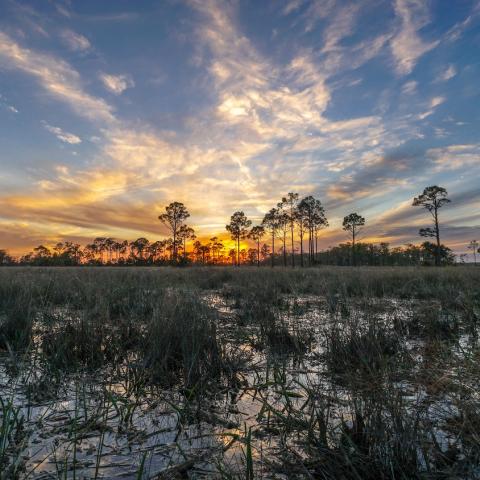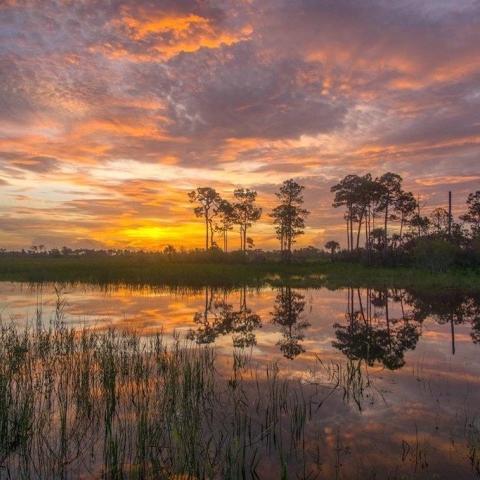
This image of a seismic line in Big Cypress National Preserve was captured March 6, 2020, the same day the U.S. Army Corps of Engineers expressed concerns over how Burnett Oil Co. was impacting the landscape of Big Cypress in a search for recoverable oil reserves/Kurt Repanshek
Oil exploration in Big Cypress National Preserve by Burnett Oil Co. has not been conducted in compliance with the Clean Water Act and has adversely affected the preserve's landscape, according to the U.S. Army Corps of Engineers.
In a letter sent March 6 to Burnett Oil Co. President Charles Nagel, the Corps said "the Corps concludes that the oil and gas exploration activity that was conducted equates to mechanized land clearing, ditching, and channelization. The Corps concludes that the survey activity caused an impact that resulted in a change in the bottom elevation of the wetland, that the activity caused an identifiable individual and cumulative adverse effect on aquatic function, and that the survey had the adverse effect of degrading a water of the U.S."
"Therefore, by means of this letter, the Corps is advising you that any future oil and gas survey activity by Burnett Oil Co. in Big Cypress National Preserve should
continue to be coordinated with the Corps in accordance with the Clean Water Act," continued the letter written by Robert Halbert, chief of the Corps' compliance and enforcement division. "A permit will be required of you unless and until you can demonstrate to the satisfaction of the Corps or Environmental Protection Agency, prior to commencing the activity involving the discharge, that the activity would not have the effect of destroying or degrading any area of waters of the United States."
I traveled to Big Cypress National Preserve just last week with contributing writer Kim O'Connell to see for ourselves what impacts the oil exploration was having on Big Cypress. The photo above is just one example of what we found. Later this week we'll have a more extensive article on the matter, along with videos, that raise questions of whether Burnett has been fulfilling its obligation to fully mitigate impacts of its work.
A Big Cypress official said Saturday they were unaware of the Corps' letter and had no immediate comment.
In March 2018, a company spokesperson told the Traveler that Burnett was "committed" to repairing the damage.
"... Burnett has an unwavering commitment to ensuring any temporarily affected areas are mitigated appropriately under the supervision of the NPS," Alia Faraj-Johnson said in an email at the time.
It was back in 2016 that the National Park Service gave the go-ahead for Burnett to explore for deposits beneath Big Cypress, even though the company's test of its equipment was judged "clearly a failure" by park observers. Drawing the condemnation was the Park Service's announcement that May that it had concluded that allowing Burnett Oil to use seismic testing to search for oil reserves in the preserve's Nobles Grade area would have "no significant impact."
"Considering the field test and also the mitigation requirements that are outlined both in the revised EA (environmental assessment) and the FONSI (Finding of No Significant Impact), the decision is that the short-term impacts can be minimized and mitigated for," then-preserve spokesman Bob DeGross said during a phone call. "Following the mitigation requirements will lessen the long-term impacts.”
In approving Burnett's request to survey the preserve for oil with vibroseis trucks, the Park Service set 46 requirements. Among those 46 mitigations were the following four specific to ground and vegetation disturbances:
17. Low shrubs and herbaceous vegetation, topsoil, rootstock, and plant material will be left in place along source lines, receiver lines, and access routes to facilitate natural re-vegetation. Also, marred or wounded standing trees will be treated with a commercially available, non-toxic pruning paint or wound coating.
18. Ruts, depressions, and vehicle tracks resulting from field operations will be restored to original contour conditions concurrent with daily operations using shovels and rakes to prevent the creation of new trails. Field clean-up activities will begin immediately upon completion of each task, and final clearance will be documented by and coordinated with NPS inspectors to the satisfaction of the Superintendent.
19. Where vegetative trimming is required, areas with native vegetation will be avoided if trimming areas with exotic vegetation can accomplish an acceptable positioning of vibration or receiver points.
20. Trimming native vegetation below the height or beyond the width of 36 inches or with a 4-inch or greater trunk diameter as measured at breast height will be avoided.
When the preserve was created, the Park Service was given the surface rights, while the mineral rights were retained by the previous owners. While the preserve is home to the endangered Florida panther, the U.S. Fish and Wildlife Service has never defined critical habitat for the big cat, and so how the testing might impact the panthers was not an overriding factor.
Burnett's exploration in 2017 and 2018 involved sending out 33-ton trucks to methodically crisscross the survey area while "listening" for seismic signals that could indicate oil reserves. If sizeable reserves were identified, the company would have to submit a plan of operations for drilling. The Big Cypress staff would typically produce an environmental assessment on that plan, and it could point to the need for a more robust environmental impact study.
Burnett sent its teams out in 2017 and 2018, and while reclamation was to have occurred almost immediately in the wake of the vibroseis vehicles' path, wet conditions at times prevented that from occurring. Today, two years later, some of the paths are virtually devoid of regrowth, while other areas show troughs that unnaturally hold water that impedes recovery of some native plant species while allowing species that normally wouldn't take root.
“It’s a shame so much damage has already been done to this remarkable national treasure,” said Jaclyn Lopez, Florida director at the Center for Biological Diversity. “The Corps’ findings underscore why seismic activities shouldn’t be allowed in the preserve at all. The immediate threat to Florida’s captivating biodiversity is too great.”
At National Parks Conservation Association, Dr. Melissa Abdo, Sun Coast regional director, said, "(T)axpayers and our nation have invested over one billion dollars in restoring America’s Everglades. The impacts of Burnett’s oil and gas exploration occurring inside the boundaries of Big Cypress are creating massive rutted cuts across the landscape, altering the natural vegetation, and significantly, altering the water distribution across the landscape.
“We cannot allow irresponsible new oil and gas exploration inside Big Cypress, a critical part of the Greater Everglades ecosystem, to impede our investment and efforts to restore America’s Everglades.”
The Center for Biological Diversity, Natural Resources Defense Council, Conservancy of Southwest Florida, National Parks Conservation Association, and others sued the Park Service in 2016 to prevent the company from destroying the preserve through seismic exploration activities to prospect for oil and gas, but a federal judge upheld a permit issued by the National Park Service.
The Corps had previously determined that a Clean Water Act permit was not required in 2017.



 Support Essential Coverage of Essential Places
Support Essential Coverage of Essential Places







Comments
Please stop destroying land for the sake of greed and causing possible extintion of plants ,animals etc, that were here before us. Save it for the future ,so our children can see the beauty of the world we have lived in.
An almost identical proposal for such work was stopped when the superintendent, Regional Director and Director of the NPS stated in writing that an EIS would be required. Yet this proposal proceeded and now clearly has not been monitored. There have been several articles about the damages being done and yet someone on the ground seems to be ignoring it or someone higher up is forcing silence. Sad!
Burnett should be held to the letter of the agreement and the law as well as their commitment to mitigate any damages.
Now would be a good time to start that - some years after it was first needed.
This is hardly a surprise, unfortunately.
The NPS made a major error in permitting this operation. This type of damage is not surprizing and was clearly predicted in the EA as well as in numerous comment letters submitted on the proposal. The permits should not have been approved without an EIS and then any resulting permit should have had extensive mitigation measures and adequated bonding tied to clear restoration responsibilities.
Who let them in there in the first place? They should be FIRED!
Great story, raw deal.